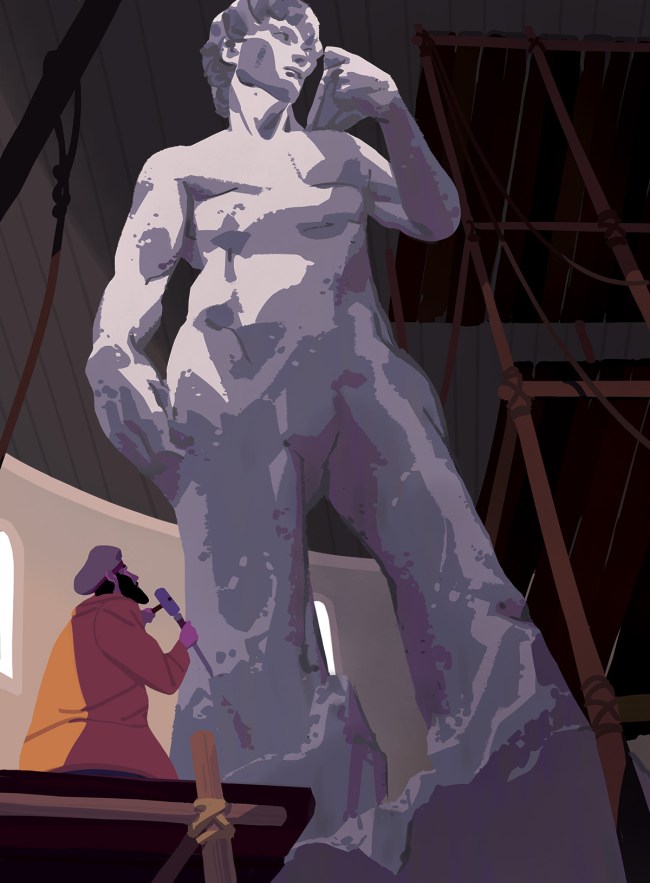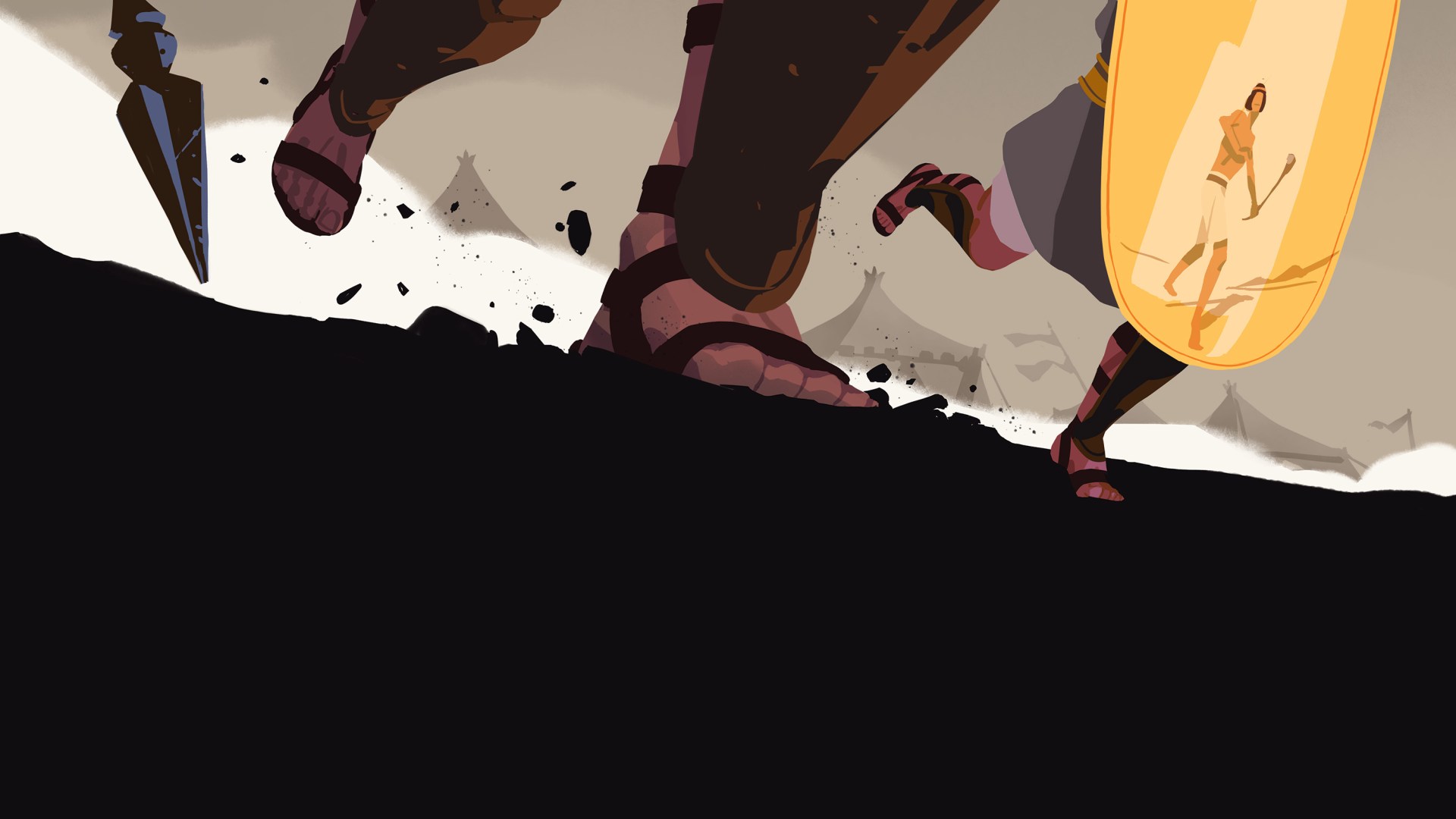Six hundred years ago, the leaders of Florence, Italy, gazed upon their magnificent cathedral and felt something was lacking. They decided to commission a dozen statues to line the roof’s buttresses. These were to be among the finest statues in the world.
The first commission went to Donatello, the most influential sculptor of the early Renaissance. Other commissions followed. Eventually, a colossal block of marble that came to be nicknamed “the giant” was hauled to Florence for what would be the most ambitious of the statues: a towering likeness of David, the Old Testament king.
But the project stalled. One artist and then another quit. The task was immense, the marble mediocre.
Finally, nearly four decades after chisel had first been put to stone, another sculptor agreed to finish the piece. A 26-year-old named Michelangelo worked the block day and night, removing multiple tons of marble. Characteristically, Michelangelo often neglected to eat or change clothes.
Three years later, Michelangelo’s David was unveiled. The 17-foot-tall colossus stood for centuries outside the entrance of Florence’s town hall as an unmistakable symbol of the city-state’s strength and resistance against outside invaders. In the art museum where David resides today, the Galleria dell’Accademia, millions of visitors pass under the gaze of what remains the world’s most famous statue.
Florentines lauded David immediately. But the sculpture was not without controversy. For the same reason you may have giggled at it in middle school, authorities had it clad with a fig leaf off and on for centuries.
Also startling was the choice of scene: Instead of sculpting David standing triumphant over the severed head of Goliath, Michelangelo depicted David before the fight, full of rage and fury and the knowledge of what he must do.
Michelangelo’s most unusual artistic decision, though, was possibly David’s age. The sculptor chose not to depict his subject as a sleek prepubescent boy the way Donatello had a couple of decades earlier in bronze, or the way other Renaissance artists had. Michelangelo’s David looks like a fully grown Olympic decathlete. Like a young man who might pursue a lion on foot and kill it with oversized hands.
 Illustration by Patrick Leger
Illustration by Patrick LegerIf Michelangelo’s brawny statue is the world’s most recognizable likeness of Israel’s most famous king, why do we continue to think of David battling Goliath as a child?
On my son’s bookshelf sit half a dozen children’s Bibles. Some are hand-me-downs from the 1980s and ’90s; others are from this millennium. In all of them, David is a boy between the ages of 8 and 12—an innocent Sunday school cartoon.
Chances are, you grew up with the same puny David as I did: hopelessly small, draped in Saul’s armor as in a drooping bedsheet, eyes covered comically by Saul’s helmet.
This version of David is not confined to children’s Bibles. He has appeared in countless sermons. Billy Graham referred to “little David.” Jewish commentaries and translations, too, have often treated David as a little guy.
Certainly, David the child preaches well: Dare to be a David! You too can defeat giants if only you believe! And he has an important theological role to play: A small David helps us emphasize a great God.
But the boyish picture of David obscures the reality of a much more nuanced character. Many of us formed that picture likely because of the ambiguity of a single Hebrew word and the ways Bible translators chose to render it in English. To see who David really was—to understand why he was ordained as a king, why he fell from grace, and why that matters for us today—we need to learn to see David a little more like Michelangelo did.
On the field of battle that fateful day, Goliath met not a child, but a man.
More than 1,200 years before Christ, waves of new settlers began entering the lower coastal regions of the Promised Land.
The newcomers were a formidable people. Because of them, the route of the Hebrew exodus could not hug the shores of the Mediterranean but instead detoured deep into the desert. War with this people, God said, might make the Israelites “change their minds and return to Egypt” (Ex. 13:17).
We know them as the Philistines.
Unlike earlier inhabitants of the land, the Philistines were not Semitic. The Bible describes them as arriving from the sea, from Caphtor (Amos 9:7), or modern-day Crete. But according to Israeli archaeologists Trude and Moshe Dothan, Crete was probably not their homeland. Their names and archaeological remains point even farther, to the Aegean Sea—specifically, to southern Greece. The Philistines are likely the first Europeans in the Old Testament.
Their memory will forever endure the infamy of being the principal enemy of the Hebrews. Thesauri list synonyms for the adjective philistine such as barbaric, uncultured, and savage.
The opposite was true.
The Philistines were seafarers, traders, “accomplished architects and builders, highly artistic pottery makers, textile manufacturers, dyers, metalworkers, silver smelters, … and sophisticated urban planners,” the Dothans write in People of the Sea.
The Hebrews, in contrast, mistrusted the waters (making Jonah’s flight to Tarshish even more extraordinary). They didn’t sail. But the Philistines had cross-pollinated their technology, art, culture, and military techniques with the other advanced cultures around the Mediterranean. The Egyptians referred to the Philistines as one of the “sea peoples,” a somewhat mysterious collection of groups that posed a threat to Egypt, the Dothans record.
By the time of King Saul, David’s predecessor, the Philistines had made significant gains into Hebrew lands. In battle after battle they defeated Israel, even confiscating the ark of the covenant and housing it in the temple of their god, Dagon.
Finally, sometime around 1000 B.C., after centuries of gaining ground against Israel, the Philistines marched into the hills above the Valley of Elah. It was Israel’s doorstep. And they gazed across it, planning their next move.
David Tsumura, an Old Testament professor at Japan Bible Seminary, writes in his commentary of 1 Samuel that the Elah Valley was “the natural point of entry from the Philistine homeland into the hill country of the Saulide kingdom. The battle was thus crucial.”
Translation: Lose the valley, lose everything.
For 39 days, the Philistine and Israelite armies stared at each other across the low valley, each clinging to their high ground. Battle was imminent, but neither side dared charge ahead. All militaries knew that attacking from below was a death wish.
For 39 days, morning and evening, a champion of the Philistine army came out to taunt the Israelites, cursing them and cursing God. “This day I defy the armies of Israel!” Goliath shouted. “Give me a man and let us fight each other” (1 Sam. 17:10).
And for 39 days, no Hebrew stepped forward. Bible commentators note that Goliath’s monologue highlights Saul’s incompetence. The giant’s ridicule focuses all attention on the king’s humiliating inaction.
In the ancient Mediterranean world, a good king was expected to go out ahead of his people. Earlier, and against the prophet Samuel’s warnings, Israel had asked for a king specifically because they wanted someone “to lead us and to go out before us and fight our battles” (1 Sam. 8:20).
Beyond that, Goliath was impressive in size and the possessor of the best weaponry and armor the Mediterranean world could offer. The best Israelite to fight him should have been someone also famous for his size, for his victory in every endeavor, and for the quality of his armor and weapons.
Saul was “as handsome a young man as could be found anywhere in Israel, and he was a head taller than anyone else” (1 Sam. 9:2). Physical description is so rare in the Bible that we don’t even know what Jesus looked like, but Saul’s exceptional height is mentioned twice (10:23).
It was no mystery who Goliath was waiting for. We can almost imagine Saul shrinking under the scorn of his soldiers. But it was not enough to make him go before his people.
Someone else would have to.
According to Davidic scholar Steven McKenzie, David likely came from a noble class. His misfortune was being born the eighth son in his family. The family’s belongings and land were already spoken for; he would inherit little in the way of the world.
The shepherd from Bethlehem would need to make his own path.
At a young age, he trained in various skills. One of Saul’s servants described David this way in the days before the Philistine battle: “I have seen a son of Jesse of Bethlehem who knows how to play the lyre. He is a brave man and a warrior. He speaks well and is a fine-looking man. And the Lord is with him” (1 Sam. 16:18).
David was a skilled musician and had a way with words. But he was also referred to as a brave man of war. Yes, a man.
During Israel’s standoff with the Philistines, Jesse wanted to supply food to his three oldest sons, who had gone to war, at the front (1 Sam. 17:13, 17–19). As the patriarch of a family of some standing, Jesse also took responsibility for sending food to other troops. The problem was, the front was 15 miles from Bethlehem. Somebody needed to carry all those supplies.
Jesse chose David and loaded him down with an ephah of roasted grain—about 36 pounds, according to the translators of the NIV. To that he added 10 cheeses, which Anton Deik, a native of Bethlehem, Palestine, and a lecturer in Biblical studies at Bethlehem Bible College, estimates would have weighed about 200 grams per cheese, or close to five pounds in total. Pile on 10 loaves of bread and a staff, and David was probably carrying at least 45 pounds.
Have you ever tried carrying 45 pounds on a 15-mile hike?
I reached out to a friend, a former US Marine. I asked about his longest ruck hikes when he was serving. In training exercises, he carried—can you guess?—about 45 pounds. Sometimes he shouldered the load at a slow run for five miles, maybe eight. For multiple-day field trainings, he carried heavier packs and walked distances approaching 15 miles.
But David wasn’t walking. The Hebrew word rûṣ, or “run,” peppers the story like a punctuation mark, appearing nearly every time David moves. David proceeds breathlessly from run to run—as if he’s forgotten how to walk.
David is no child. He’s more like a Marine.
 Illustration by Patrick Leger
Illustration by Patrick LegerOn day 40 of the conflict, David arrives at the Valley of Elah as the battle lines are reforming and the Israelite soldiers are shouting their daily war cry (1 Sam. 17:20). One can’t help but imagine that cry sounds a bit hollow by now.
David leaves the supplies with the appropriate camp staffer and runs (again with the running) to his older brothers to greet them and get a report. The update from his brothers is interrupted when the Philistine giant resumes his liturgical taunts.
Goliath towers over normal men. There’s some variance in the ancient manuscripts about his height: Is it six cubits and a span (9.5 feet) or four cubits and a span (7 feet)? But the fact that such a fuss is made of his height and that the very tall Saul is terrified points to the larger measurement. “In text-critical terms, six cubits and a span is the number to beat,” says Peter J. Williams, who runs Tyndale House, Cambridge, a biblical studies research center in England.
The big man isn’t the only reason for fear, however. The Philistines are a superior army, better trained and better outfitted with modern weapons. They’ve known little but victory against the Hebrews.
All Israel shakes in their sandals. Except for David, that is. The shepherd is angry.
David asks around about what will be done for the one who defeats the Philistine. Word gets to King Saul, who summons David.
The next verses in the story, and the way they translate the Hebrew word na’ar, are the reason we’ve misinterpreted it.
In the NIV Bible that my generation was raised on, the 1984 edition, David says to Saul in 1 Samuel 17:32: “Let no one lose heart on account of this Philistine; your servant will go and fight him.”
Saul replies, “You are not able to go out against this Philistine and fight him; you are only a boy, and he has been a fighting man from his youth.”
It is not the only translation that calls David a boy.
The historic KJV and its grandchild, the ESV, use the term youth for David. Certainly closer to reality, but still vague.
The NIV update in 2011 replaced its original boy with young man.
So which is it?
The word na’ar is notoriously broad, says Michelle E. Knight, assistant professor of Old Testament and Semitic languages at Trinity Evangelical Divinity School. Na’ar can refer to a teenager, a lad, or even a baby boy in the womb. Or to an (unmarried) warring general in his mid-20s, like Absalom.
Reading David as a boy is wrong, Knight tells me, “but it’s not surprising to me that that’s how people have done it.”
Even some influential teachers in the early church, like John Chrysostom and John Cassian, made the same mistake. They treated David as a child. Na’ar can be applied correctly to Donatello’s bronze boy David and Michelangelo’s man David.
We can’t know David’s age for certain. But we do know he is not a child.
“He’s a strapping young man,” Knight says. She thinks David is in his early 20s, or upper teens at the youngest. “He’s at least the 17-year-old that can do all your lawn work for you because he’s stronger than you are.”
“It’s going to be above 20,” Williams tells me. The problem with David as a boy, Williams says, is not just what comes before, but what comes after. Scripture tells us David will become king at age 30. It’s difficult to argue that the interim period between David’s defeat of Goliath and his becoming king could have lasted any longer than 10 years.
But more than this: If David fights as a child, the story is simply untellable.
It’s a reasonable assumption that if David is a boy, Saul would never send for him. This is a field of battle. A boy would be laughed at and patted on the head, even sent away. But David is taken seriously.
Saul expresses no concerns with David’s size or physique. The king’s reservation is clear: David lacks fighting experience. “Saul replied, ‘You are not able to go out against this Philistine and fight him; you are only a young man, and he has been a warrior from his youth’ ” (1 Sam. 17:33).
In response, David unrolls his résumé.
But David said to Saul, “Your servant has been keeping his father’s sheep. When a lion or a bear came and carried off a sheep from the flock, I went after it, struck it and rescued the sheep from its mouth. When it turned on me, I seized it by its hair, struck it and killed it. Your servant has killed both the lion and the bear; this uncircumcised Philistine will be like one of them, because he has defied the armies of the living God. The Lord who rescued me from the paw of the lion and the paw of the bear will rescue me from the hand of this Philistine.” (vv. 34–37)
David is swift of foot and sufficiently built to chase down a bear or a lion, seize it by its mane, and bludgeon it to death with his shepherd’s staff. He is driven, and he wins the king over.
Saul’s response is straightforward: “Go, and the Lord be with you” (v. 37).
But what about all those pictures of David drowning in Saul’s armor?
Then Saul dressed David in his own tunic. He put a coat of armor on him and a bronze helmet on his head. David fastened on his sword over the tunic and tried walking around, because he was not used to them.” (vv. 38–39)
As an exceptionally tall man, Saul probably would not have bothered putting his armor on David if he were a child. It wouldn’t have suited him. It would have been a waste of time. And in a shame-honor culture like ancient Israel, no king would allow a child to fight for him. It would have been humiliating. Goliath might have refused to fight a child, or David’s older brothers might have dragged him off the field.
Don’t forget: Within a few short years, David and his other elite warriors will each go on to kill hundreds of enemy fighters (2 Sam. 23:8–39).
Some scholars also think there may have been some trickery involved in Saul’s dressing David in his armor. The king could have offered David someone else’s armor, or perhaps sent an aide to fetch a set more David’s size. But Saul may have had an ulterior motive. John Walton, professor of Old Testament at Wheaton College, writes in one of his commentaries that Saul may have wanted “vicariously to share in any possible victory.”
In an age before visual media, few Philistines would know what King Saul’s face looks like. If David wears the king’s armor, the ranks of Philistines would likely think it is the king of Israel himself coming out to fight Goliath.
David will be king soon enough. But he dons Saul’s armor only long enough for a moment of ironic foreshadowing, then takes it off.
“I cannot go in these,” he says to Saul, “because I am not used to them” (v. 39).
The armor fits David just fine, but he can’t fight in it. He’s never worn it before. He isn’t about to put his life on the line in armor that feels alien and strange.
Instead, he takes the two weapons he has tested: his staff and his sling.
An ancient sling was not a slingshot, some backyard toy barely capable of downing a bird. A sling was a devastating weapon. More accurate than a bow and easier to make, it was a favorite tool of shepherds and warriors.
Slings were made from a long woven cord threaded through a pouch. The cord was doubled over on itself, and a baseball-sized stone was slung in the pouch. A user whipped the doubled cord around at many revolutions per second then released one end of the cord and, in turn, the projectile.
“In the hands of an expert, a heavy sling bullet or stone could reach speeds of up to 100 mph,” journalist Tom Metcalfe writes in Scientific American.
Have you ever seen a Major League Baseball player try to get out of the way of a pitch? They often can’t. Now imagine a pitch that could cleave your skull.
Ancient slingers were incredibly accurate. In the Book of Judges, they were said to be able to “sling a stone at a hair and not miss” (20:16).
But if they’re so accurate, why does David bother collecting five stones instead of just a couple?
Because Goliath is prepared for slingers and brings along the perfect defense—a shield carrier.
That’s right, there are not just two men on the field of battle; there are three. Every Bible translation notes this. The shield bearer is often missing from children’s stories, but the Bible is clear. He walks in front of Goliath, and his sole job, Williams tells me, is to protect Goliath from projectiles. David is ready for all five of his stones to be deflected and, if necessary, to move into close combat with his staff.
This third man on the field has often confused interpreters of the Bible’s best-known battle scene. In 2013, for instance, journalist Malcolm Gladwell in his bestseller David and Goliath portrays the shield bearer as a sort of caddie, an invisible helper.
But this is not his job.
It’s a shame to train a champion for decades when any shepherd could take him out with a well-aimed stone or arrow. This is why a shield carrier would go ahead of the champion. His sole role was to protect the star from projectiles. According to Williams, the shield carrier would neutralize projectiles from the opposing champion until the combatants could come close enough for hand-to-hand fighting.
Gladwell was perhaps unaware of this, so instead he constructed an odd theory that Goliath may have suffered from acromegaly, a condition sometimes accompanied by poor eyesight, and that the big man required a shield carrier to serve as something like his seeing-eye dog.
The actual story is as clear as Goliath’s vision:
And the Philistine moved forward and came near to David, with his shield-bearer in front of him. And when the Philistine looked and saw David, he disdained him, for he was but a youth, ruddy and handsome in appearance. And the Philistine said to David, “Am I a dog, that you come to me with sticks?” (1 Sam. 17:41–43, ESV)
Goliath sees David perfectly well, even from a distance. He observes that the shepherd is a na’ar and takes in his complexion. He does not see multiple of David’s staff, as Gladwell interprets Goliath’s taunt; the plural sticks is simply a pejorative, as Bible translators have noted. And resting on Goliath’s person are three weapons. One of them is a distance projectile—difficult to use if you can’t see (v. 6).
David speaks the last words the Philistine will ever hear:
You come against me with sword and spear and javelin, but I come against you in the name of the Lord Almighty, the God of the armies of Israel, whom you have defied. This day the Lord will deliver you into my hands, and I’ll strike you down and cut off your head. This very day I will give the carcasses of the Philistine army to the birds and the wild animals, and the whole world will know that there is a God in Israel. All those gathered here will know that it is not by sword or spear that the Lord saves; for the battle is the Lord’s, and he will give all of you into our hands. (vv. 45–47)
Goliath approaches, and David runs “quickly toward the battle line to meet him” (v. 48).
Presumably, Goliath isn’t worried about the slinger. Presumably, for his long career, he’s never been let down by the shield carriers who ran in front of him—at least not fatally.
Then the fight comes—and goes. In a chapter 58 verses long, the action occupies only a few.
“Reaching into his bag and taking out a stone, he slung it and struck the Philistine on the forehead. The stone sank into his forehead, and he fell facedown on the ground” (v. 49).
The wound is likely mortal. The Hebrew word for the stone sinking into his forehead is the same word used in the Book of Lamentations to describe gates sinking into the earth (2:9). The image stays with you.
What happens next may be to make sure he’s dead or, as Tsumura argues, to fulfill his promise to Goliath in verse 46: “David ran and stood over him. He took hold of the Philistine’s sword and drew it from the sheath. After he killed him, he cut off his head with the sword. When the Philistines saw that their hero was dead, they turned and ran” (v. 51).
It’s a fitting end, says Matthew Patton, an Old Testament scholar and Presbyterian pastor in Ohio.
Not long before, when the Philistines confiscated the ark of the covenant, they placed it in Dagon’s temple beside his supreme statue. In the morning they arose and discovered the statue fallen, prostrate before the ark. They righted the statue, but the next morning it lay prostrate again, its head shorn from its bust (1 Sam. 5).
“You become like what you worship,” Patton tells me.
Forty days of fear end in the unlikeliest of triumphs. Yahweh prevails. A young man with neither sword nor shield fells the champion of the Philistine army. The Philistines flee and Israel pursues.
The million-dollar question is: How did David get a stone past the shield carrier?
Scholars have speculated. Maybe David was a lefty, which threw the shield carrier off. Many of the best slingers in Israel were left-handed (Judges 20:16). Or maybe David simply tricked the shield carrier, feinting or deking in one direction and releasing the stone in another. Or, since David had already served as King Saul’s armor-bearer (1 Sam. 16:21), maybe he knew some tricks to outmaneuver one.
The only thing the text tells us, again and again, is just how fast David is. The language surrounding Goliath’s movements continually “contrasts the ponderous motion of the Philistine with the lightning-fast moves of David,” writes Old Testament scholar Ralph W. Klein in his commentary on 1 Samuel. Perhaps David’s speed was simply too much, and the shield carrier couldn’t lift the shield quickly enough to protect the giant’s forehead.
Whatever David did, he surprised not only Goliath but everyone on the battlefield.
The shepherd is not the champion Israel’s people expected—tall like Goliath or good at everything like Saul. David is, in a way, better. He is God’s champion. Another recursion of the divine pattern of foolish things shaming the wise (1 Cor. 1:27). A presage of his descendant who would come 1,000 years later, born in his hometown to a virgin mother.
But David’s opportunity that day came at the failure of Saul. King Saul refused to go before his people as he had been chosen to do, electing instead to hang back from the fight.
It is perplexing that the exact same failure, years later, will be David’s downfall when he is at the height of his power. “In the spring, at the time when kings go off to war,” 2 Samuel 11:1 says, “David sent Joab out with the king’s men and the whole Israelite army. They destroyed the Ammonites and besieged Rabbah. But David remained in Jerusalem.”
The late Bible scholar Ronald F. Youngblood writes in his commentary, “The narrator thus leaves the impression that every able-bodied man in Israel goes to war—everyone, that is, except the king himself: ‘But David remained in Jerusalem.’ The contrast between David and his men can hardly be expressed in starker terms.”
David stays back. He does not go before his people. He gets distracted. In a city where he should not be and in a palace where he should not be, he wanders onto his roof and beholds a bathing woman named Bathsheba, the wife of one of his 37 most faithful and elite soldiers (2 Sam. 23:39).
And once again, a king summons his subject. We know what comes next: An encounter David thinks he can hide becomes Bathsheba’s unexpected pregnancy. David’s scheme to deceive her husband, Uriah, fails. David writes not another psalm with which to bless the world, but a sealed letter containing Uriah’s death sentence, carried by Uriah himself back to his commander on the battlefield (2 Sam. 11:14).
 Illustration by Patrick Leger
Illustration by Patrick LegerWithin his lifetime, David was both hero and cautionary tale. He remains so today.
By seeing David for who he really was on the day he faced Goliath—a fearless, athletic, charismatic, attractive, silver-tongued, fully grown man—we begin to see someone who looks a lot like the celebrity pastors and ministry leaders who have risen to command their own evangelical kingdoms today.
Evangelicals are rightly wrestling with the temptation to turn faith leaders into celebrities only to watch their heroes tarnish and morally compromise themselves. We are rightly asking whether celebrity itself is what corrupts.
But in David’s case, God thrust the shepherd into celebrity. It wasn’t an accident. He was anointed, unbidden, as a king (1 Sam. 16). David wasn’t some aw-shucks little kid. By all appearances, he was cut from the same cloth as Saul. God did and still often does choose the talented and the exceptional to lead his people.
But as we’ve seen time and again, such leaders face all the more temptation to forget for whom they’re working. Even our most gifted leaders can be overcome by sin—perhaps especially the most gifted. Internet debates have flared in recent years about whether David committed rape and whether he should be canceled. But the critiques have a way of presenting a man who is separate from the one who burst onto the biblical stage standing over a giant’s corpse. They are one and the same David.
If we stick only to the “God can use anyone” reading of David’s origin story, we celebrate God’s elevation of the overlooked and risk missing God’s clear warning to the elevated: It can happen to you. But if we see David for who he really was, we realize that every great man or woman who rises to power in the church is only one rooftop stroll away from a David-sized crash.
We don’t know what, if anything, David’s inner circle might have done to try to keep his temptations in check. Did his advisers urge him to spend more time on the battlefield? Did anyone inquire about what pressing matters were keeping him in the palace? The organizational takeaways are unclear.
Fortunately, David’s story did not end in perpetual denial and hardheartedness, the way celebrity pastor scandals often do. David was eventually called to account for his sin. He repented, recording his contrition with hundreds of words in the Psalms. He was tormented for the rest of his life by his choice and watched his family and kingdom fall apart.
And fortunately, unlike with David, there was one coming who would not fall. There was one coming who was something like David at his best, but better. He was not what the world expected. He was a grown man and undeniably gifted, but he did not seem properly trained or outfitted. He was tempted in every way but would not give in (Heb. 4:15).
He was the right man for the job.
In Genesis 3, God told the Serpent that the seed of Eve and the seed of the Serpent would continue on in enmity. The Serpent would strike at the offspring’s heel, but he would crush the Serpent’s head.
David was not quite a fulfillment of this prophecy, but it’s hard not to hear its reverberations in his fight with Goliath. Once again, a great enemy approached God’s people, spouting lies and wearing scales (1 Sam. 17:5). This time, instead of giving in, a descendant of Adam crushed the enemy’s head.
David was a new and better Adam. And Jesus is a new and better David.
In 2 Samuel 7, God gave David one of the Old Testament’s most important prophecies and covenants:
I will raise up your offspring to succeed you, your own flesh and blood, and I will establish his kingdom. He is the one who will build a house for my Name, and I will establish the throne of his kingdom forever. I will be his father, and he will be my son. (vv. 12–14)
One will come from David’s line whose palace will be undefiled, whose kingdom and whose throne will last forever. He will be God’s Son.
As the Son, he’ll be like the Father. And we can’t help but feel that, as a descendant of David, he’ll have the best of David, too. He too will be the Good Shepherd, pursuing the predator who snatches his sheep, grabbing fistfuls of its hair, readying his rod. Like David, he will go before his people. While we tremble on the hill, he descends into the valley. He will be our champion. He may not be what we expect, but he’s better. And he’s not afraid.
The ancient Israelites, upon hearing of David and Goliath, would not have identified with David. Patton, the Old Testament scholar, tells me they would have identified with the trembling Israelite soldiers. After God provided for their miraculous victory through David, they joined in the fight to finish the Philistine army.
Yes, David’s story is a cautionary tale. Yes, it can inspire us to “dare to be a David.” But its most important lesson for us today is to recognize that God has sent a new and better David on our behalf. He goes before us as our champion, and we as the church are called to join him.
“The ultimate serpent-crusher is Jesus, but we in union with Jesus are also part of the serpent-crushing mission,” Patton says.
Jordan K. Monson is an author and professor of missions and Old Testament at Huntington University.















